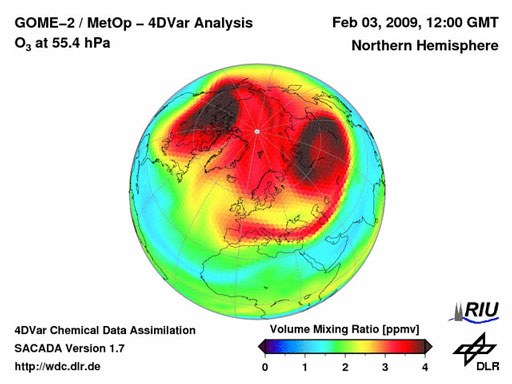GOME-2 detects stratospheric warming in the Northern Hemisphere

Stratospheric warmings are one the most dramatic phenomena of the atmosphere: this spontaneous warming of the winter stratosphere is sometimes even linked to a reversal of the large scale circulation.
Due to a lack of solar radiation a very cold vortex, the so called polar vortex, forms each year above the particular winter pole in the stratosphere. Its high velocities between 60 m/s and 100 m/s which allow a complete rotation within five to seven days block the exchange of air masses: the polar air masses are separated from the surrounding atmosphere. Inside the polar vortex the lack of solar radiation and the consequently very low temperatures lead to very effective ozone depletion.
But these polar dynamics are very sensitive to so called planetary waves acting to some extent like a “giant planetary mixer”: when they break down they deposit energy and momentum on the surrounding wind field. If the energy transferred is high enough, the result is a weakening of the polar vortex. That means the polar vortex is deformed, shifted or even split up and therefore also the area of reduced ozone. Such a phenomenon is currently observed above the Arctic. On behalf of EUTMETSAT DLR routinely assimilates data from the GOME-2 instrument on board the satellite MetOp into a 4D-var atmospheric model. Global maps of different trace gases are produced and made available at the ICSU/WMO world data centre for remote sensing, WDC-RSAT, at DLR.
Due to the weakening of the polar vortex exchange of air masses with other atmospheric regions becomes possible resulting at last in a relatively fast warming of the stratosphere. If this effect is strong enough, a temporary circulation reversal happens – easterly winds instead of westerly winds: the circulation switches to summer conditions for some time.
Why and when planetary waves carry enough energy to cause a stratospheric warming is an unsolved problem until today. Due to this reason stratospheric warmings can hardly be predicted by atmospheric models although they normally happen once a winter at least. This topic is part of actual research activities at DLR.

